最新外研版四年级上册英语导学案(全册 三起点)
外研版小学英语四年级上册Module 3教案

Unit1What are they doing? 1课时
Unit 2 What'sthe elephant doig?1课时
Unit1 What are they doing?
学习目标
1.学习询问他人正在做什么事情。
2.描述他人正在做的事情。
3.学生能够听、说、认boat chess row soybean milk drink hungry 。
主备人:使用人:课时:2
课题
Module3
课型
新授
修改意见
单元备课
教学内容:谈论人们在公园中的活动,并描述正在发生的行为或动作。本模块是继上一模块对现在进行时态的学习之后,继续对其进行复习和巩固。在复习已学的动词和动词词组的过程中,不断引出更多动词词语的学习。第一单元中Amy和Dming来到公园,乘坐公园bus开始游览。这期间,Dming向Amy介绍许多有趣的事,Amy也对其抱有极大的兴趣。第二单元中则主要学习如何询问和讲述他人正在做的事。
3.请全体学生一起边做动作,边说:I’m doing taijiquan.
4.自主学习单词(Task 1) (1)Listen and underline the new words and the difficult words. (2) Listen and read the new words and the difficult words 3 times. (3)Read the words by yourself.
4.通过创设和谐的氛围,让孩子们轻松愉快地学习英语,并形成良好的英语语 感。
教学重点
1.学说问句What are they doing?
2.掌握句型They’re 动词+ing [+宾语]
外研版(三起点)四年级英语上册《Module2_Unit1_名师教案》

Module2 Unit1教案【内容来源】外研版三起点(2013年审定)四上Module2 Unit1【主题】She’s reading a book.【课时】此教学设计按单元写,教师可根据实际情况划分课时。
一、教学目标(Teaching aims)(1)学生能理解对话,并学会运用句型..like(s) doing sth.和现在进行时态句型结构“主语+be+ doing sth.”。
(2)学生能听懂,会说,会用read, running, take pictures.(3)学生能够听懂、会说、会表演课文内容并在能正确表达图中人物正在进行的动作。
二、教学重难点(Teaching points and difficulties)(一)重点(Points)谈论图片上正在发生的事情和词汇read, running, take pictures.(二)难点(Difficulties)谈论正在发生的事情。
三、教学准备(Teaching preparation)多媒体PPT课件。
教学过程采用任务型教学法、情景教学法、TPR教学法、交际法。
四、教学过程Step 1: Warm-up & Lead in1. Greetings and chant.师生间简单地打招呼。
教师播放ppt第2页的歌曲动画,请学生Sing and do边唱边做动作。
欢快又熟悉的节奏可以活跃课堂气氛,同时感知ing形式表示现在正在进行的动作。
2. Look and say.教师出示第3页ppt,学生观察图片,说一说图中人物动作表达他们的爱好,引出语法like doing sth.3.Let’s read.教师出示第4页ppt,看图读句子注意like doing sth.的用法,尤其注意swim的-ing形式:双写m加-ing.Step 2: Presentation1. Listen, point and say.学生讨论积极回答,引导学生正确使用like doing sth.(2)出示第6页ppt,朗读课文,标注重点并讲解:like doing sth.喜欢做某事。
四年级英语上册全册导学案(外研版)
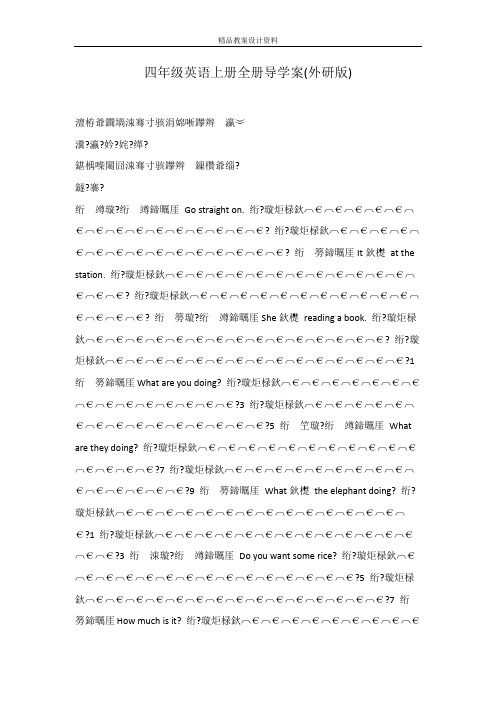
四年级英语上册全册导学案(外研版)瀵?瀛?妗?姹?缂??鐩?褰??Go straight on. 绗?璇炬椂鈥︹€︹€︹€︹€︹€︹€︹€︹€︹€︹€︹€︹€︹€︹€︹€? 绗?璇炬椂鈥︹€︹€︹€︹€︹€︹€︹€︹€︹€︹€︹€︹€︹€︹€︹€? It鈥檚at the station. 绗?璇炬椂鈥︹€︹€︹€︹€︹€︹€︹€︹€︹€︹€︹€︹€︹€︹€︹€? 绗?璇炬椂鈥︹€︹€︹€︹€︹€︹€︹€︹€︹€︹€︹€︹€︹€︹€︹€? ?She鈥檚reading a book. 绗?璇炬椂鈥︹€︹€︹€︹€︹€︹€︹€︹€︹€︹€︹€︹€︹€︹€︹€? 绗?璇炬椂鈥︹€︹€︹€︹€︹€︹€︹€︹€︹€︹€︹€︹€︹€︹€︹€?1 What are you doing? 绗?璇炬椂鈥︹€︹€︹€︹€︹€︹€︹€︹€︹€︹€︹€︹€︹€︹€︹€?3 绗?璇炬椂鈥︹€︹€︹€︹€︹€︹€︹€︹€︹€︹€︹€︹€︹€︹€︹€?5 ?绗What are they doing? 绗?璇炬椂鈥︹€︹€︹€︹€︹€︹€︹€︹€︹€︹€︹€︹€︹€︹€︹€?7 绗?璇炬椂鈥︹€︹€︹€︹€︹€︹€︹€︹€︹€︹€︹€︹€︹€︹€︹€?9 What鈥檚the elephant doing? 绗?璇炬椂鈥︹€︹€︹€︹€︹€︹€︹€︹€︹€︹€︹€︹€︹€︹€︹€?1 绗?璇炬椂鈥︹€︹€︹€︹€︹€︹€︹€︹€︹€︹€︹€︹€︹€︹€︹€?3 ?Do you want some rice? 绗?璇炬椂鈥︹€︹€︹€︹€︹€︹€︹€︹€︹€︹€︹€︹€︹€︹€︹€?5 绗?璇炬椂鈥︹€︹€︹€︹€︹€︹€︹€︹€︹€︹€︹€︹€︹€︹€︹€?7簩鍗曞厓How much is it? 绗?璇炬椂鈥︹€︹€︹€︹€︹€︹€︹€︹€︹€︹€︹€︹€︹€︹€︹€?9 绗?璇炬椂鈥︹€︹€︹€︹€︹€︹€︹€︹€︹€︹€︹€︹€︹€︹€︹€?1 ?Can you run fast? 绗?璇炬椂鈥︹€︹€︹€︹€︹€︹€︹€︹€︹€︹€︹€︹€︹€︹€︹€?3 绗?璇炬椂鈥︹€︹€︹€︹€︹€︹€︹€︹€︹€︹€︹€︹€︹€︹€︹€?5 Can Sam play football? 绗?璇炬椂鈥︹€︹€︹€︹€︹€︹€︹€︹€︹€︹€︹€︹€︹€︹€︹€?7 绗?璇炬椂鈥︹€︹€︹€︹€︹€︹€︹€︹€︹€︹€︹€︹€︹€︹€︹€?9 鏈熶腑澶嶄範绗?璇炬椂鈥︹€︹€︹€︹€︹€︹€︹€︹€︹€︹€︹€︹€︹€︹€︹€?1 绗?璇炬椂鈥︹€︹€︹€︹€︹€︹€︹€︹€︹€︹€︹€︹€︹€︹€︹€?3?Can I have some sweets? 绗?璇炬椂鈥︹€︹€︹€︹€︹€︹€︹€︹€︹€︹€︹€︹€︹€︹€︹€?5 绗?璇炬椂鈥︹€︹€︹€︹€︹€︹€︹€︹€︹€︹€︹€︹€︹€︹€︹€?7Happy Halloween. 绗?璇炬椂鈥︹€︹€︹€︹€︹€︹€︹€︹€︹€︹€︹€︹€︹€︹€︹€?9 绗?璇炬椂鈥︹€︹€︹€︹€︹€︹€︹€︹€︹€︹€︹€︹€︹€︹€︹€?1 ?There is a horse in the photo. 绗?璇炬椂鈥︹€︹€︹€︹€︹€︹€︹€︹€︹€︹€︹€︹€︹€︹€︹€?3 绗?璇炬椂鈥︹€︹€︹€︹€︹€︹€︹€︹€︹€︹€︹€︹€︹€︹€︹€?5 There are twelve boys on the bike. 绗?璇炬椂鈥︹€︹€︹€︹€︹€︹€︹€︹€︹€︹€︹€︹€︹€︹€︹€?7 绗?璇炬椂鈥︹€︹€︹€︹€︹€︹€︹€︹€︹€︹€︹€︹€︹€︹€︹€?9 ?We are going to visit Hainan. 绗?璇炬椂鈥︹€︹€︹€︹€︹€︹€︹€︹€︹€︹€︹€︹€︹€︹€︹€?1 绗?璇炬椂鈥︹€︹€︹€︹€︹€︹€︹€︹€︹€︹€︹€︹€︹€︹€︹€?3鍗曞厓Sam is going to ride a horse. 绗?璇炬椂鈥︹€︹€︹€︹€︹€︹€︹€︹€︹€︹€︹€︹€︹€︹€︹€?5 绗?璇炬椂鈥︹€︹€︹€︹€︹€︹€︹€︹€︹€︹€︹€︹€︹€︹€︹€?7 ?Are yougoing to run on sports day? 绗?璇炬椂鈥︹€︹€︹€︹€︹€︹€︹€︹€︹€︹€︹€︹€︹€︹€︹€?9 绗?璇炬椂鈥︹€︹€︹€︹€︹€︹€︹€︹€︹€︹€︹€︹€︹€︹€︹€?1 I鈥檓going to do the high jump. 绗?璇炬椂鈥︹€︹€︹€︹€︹€︹€︹€︹€︹€︹€︹€︹€︹€︹€︹€?3 绗?璇炬椂鈥︹€︹€︹€︹€︹€︹€︹€︹€︹€︹€︹€︹€︹€︹€︹€?5 ?We have a big family dinner. 绗?璇炬椂鈥︹€︹€︹€︹€︹€︹€︹€︹€︹€︹€︹€︹€︹€︹€︹€?7 绗?璇炬椂鈥︹€︹€︹€︹€︹€︹€︹€︹€︹€︹€︹€︹€︹€︹€︹€?9 Merry Christmas! 绗?璇炬椂鈥︹€︹€︹€︹€︹€︹€︹€︹€︹€︹€︹€︹€︹€︹€︹€?1 绗?璇炬椂鈥︹€︹€︹€︹€︹€︹€︹€︹€︹€︹€︹€︹€︹€︹€︹€?3 鏈熸湯澶嶄範绗?璇炬椂鈥︹€︹€︹€︹€︹€︹€︹€︹€︹€︹€︹€︹€︹€︹€︹€?5 绗?璇炬椂鈥︹€︹€︹€︹€︹€︹€︹€︹€︹€︹€︹€︹€︹€︹€︹€?7 鍖楀喍闀囧皬瀛?鍥?骞寸骇?钖涙槑浜?瀹℃牳鏁欏笀閭变附鑺?璇?棰?Module 1 unit1 Go straight on . 璇?鍨?鏂版巿璇?璇?鏃?1 鐭ヨ瘑涓庢妧鑳?eft. Right锛宼urn right(left). Go straight on ?杩囩▼涓庢柟娉?鑳藉惉?鍦ㄥ?鏁欐潗鍒嗘瀽??瀛?鍏?璇嶅崱鐗?鏁?瀛?杩?绋?鏁?甯?娲?鍔?瀛?鐢?娲?鍔?鏁堟灉鍙嶆€?瀵?鍏?鏂?璇??1.?2. 缁勫唴鍚岃3銆佽瘑璁板崟璇嶃€?4虹珵浜夊噯澶?5. 1銆?6. ?. 鑷?涓?瀛?涔?1.?2.?1. 2. 3.诲姩1銆?4. ? 灏?缁?鍚?浣?瀛愩€?1. beside the tree 2. on your left 3. on your right 4. at No. 2 Park Street 5. Excuse me . 6. Go straight on . 7. Turn left . 8. Turn right . 9. next to a cinema 10. beside the cinema 11. Thank you so much ! 灞?绀?鍙?棣?皢鍗曡瘝琛ュ厖瀹屾暣1銆乴ft 宸﹁竟锛涘悜宸?2銆乺ght 鍙宠竟锛涘悜鍙?3銆乴ve 灞呬綇4銆乻tr t 琛楅亾5銆乼r in 6銆乥s de 鍦ㄢ€⑩€⑩€㈡梺杈?7. cinema 鐢靛奖闄?8.ne 鎺ヨ繎锛屼复杩?9. h se 鎴垮眿10.s perm rket 瓒呭競閲?闅?瑙?鐤?beside the tree 鍦ㄦ爲鍚庨潰on your right 鍦ㄤ綘鐨勫彸杈?next to a cinema 闈犺繎鐢靛奖闄?鎷?灞?璁?缁?缈昏瘧鍙ュ瓙 1.?鎴戝湪浣犵殑鍙宠竟銆?2.浠栧湪鏍戝悗?1銆?瀹屾垚璇惧爞妫€娴嬩腑鐨勭浉鍏充範棰樸€?2銆??鏉夸Unit 1 Go straight on Where are you ? I鈥檓鈥?Where is鈥? It鈥檚... Behind on 鈥?left on ight Turn right turn left next to Beside go straight on鍖楀喍闀囧皬瀛?鍥?骞寸骇?钖涙槑浜?瀹℃牳鏁欏笀閭变附鑺?璇?棰?Module 1 unit1 Go straight on . 璇?鍨?鏂版巿璇?璇?鏃?2 鐭ヨ瘑涓庢妧鑳?澶嶄範宸╁浐鍗曡瘝锛岃兘澶熻繍鐢╰urn left , go straight on . ?杩囩▼涓庢柟娉?鎺屾彙?鎯呮劅鎬佸害浠峰?鏁欐潗鍒嗘瀽?闅剧偣?瀛?鍏??鏁?瀛?杩?绋?鏁?甯?娲?鍔?瀛?鐢?娲?鍔?鏁堟灉鍙嶆€?瀵?鍏?鏂?璇?1.澶嶄範妫€娴?曡瘝2.妫€娴??1.璇绘湰璇惧崟璇?2.鎸戝啓鍗曡瘝 3. 缁勫唴妫€鏌ョ籂閿欒瘎姣?鑷?涓?瀛?涔?銆?1.3銆?骞剁炕璇?2. 3. 缁勫唴绾犻敊灏?缁?鍚?浣?1.缁勫唴妫€鏌ヤ氦娴併€?2.?3.忕粍灞曠ず瀵硅瘽銆?灞?绀?鍙?棣??A: me . Where the supermarket ? B: straight on . Turn right . A: Thank you so . B锛歒ou鈥檙e . 閲?闅?瑙?鐤?straight on 鐩寸潃璧?Turn right 鍚戝彸杞?Turn left 鍚戝乏杞?鎷?灞?璁?缁?A: Excuse . is the zoo ,please ? B: left . Go straight . It鈥檚next a cinema . A: Thank you . Goodbye . B: Bye-bye . 1銆?瀹屾垚璇惧爞妫€娴嬩腑鐨勭浉鍏充範棰樸€?2銆?鑳屽啓娲诲姩4銆?Unit 1 Go straight onTurn right turn left go straight on鍥?楂樻窇璐?瀹℃牳鏁欏笀閭变附鑺?璇?棰?Module2 Unit 2 It鈥檚at the station 璇?鍨?鏂版巿璇?璇?鏃?1 鐭ヨ瘑涓庢妧鑳?璇诲彞鍨嬶細The train is going up/down/past the hill.? hill, house ,station, train, up, down. 杩囩▼涓庢柟娉??鍦ㄤ氦娴佸鐨勫搧璐?鏁欐潗鍒嗘瀽瀛︿範鍙ュ瀷The train is goingup/down/past the hill. 鎺屾彙琛ㄧず鍦扮偣鍜屾柟浣嶇殑璇?瀛?鍏?? 鏁?瀛?杩?绋?鏁?甯?娲?鍔?瀛?鐢?娲?鍔?鏁堟灉鍙嶆€?瀵?鍏?鏂?璇?I. Warming up TPR娲诲姩锛氭暀甯堟垨涓€鍚嶅悓瀛︿笅鍙d护turn left/stand up/sit down绛?鍏ㄧ彮瀛︾敓鍋氬姩浣溿€?II. Revision:妸瀛︾敓鐨勮矾绾垮浘鐢ㄦ姇褰辨斁鍑烘潵銆?1 here鈥檚 a train from Beijing to our city.Where is the train going? 灏嗙伀杞﹁创鍦ㄥ北涓婄殑浣嶇疆锛he train is going up the hill.鏉夸功璇ュ彞瀛愩€?2.here is the train going now?瀛︾敓璇村嚭锛氣€淭he train is going down the hill. 鑷?涓?瀛?涔?鏁欏笀灏嗏€渉ill鈥? 鈥漢ouses鈥? 鈥漵chool鈥? 鈥漵tation鈥?鍥剧墖浜ょ粰瀛︾敓璇rain鈥濈殑澶撮グ浜ょ粰鍙︿竴鍚?鑰佸笀璇风伀杞﹀紑鍔ㄨ捣鏉?灏?缁?鍚?浣?1 瀹屾垚P8缁冧範3銆?瀛︾敓涓や汉涓€缁勶紝瀛︾敓A璇村嚭A o straight on, turn left. It鈥檚on your night. 瀛︾敓B: Is it the supermarket? 瀛︾敓A: No, it isn鈥檛. 2 娲诲姩锛欻ow can we go to supermaket? 瀛︾敓浠ュ皬缁勪upermaket鐨勮矾绾垮浘銆傜劧鍚庡埌鍓嶉潰鏉ョ粰鍏ㄧ彮瀛︾敓璁茶В鏈€鍚堢悊鐨勪竴缁勮幏鑳溿€?灞?绀?鍙?棣?here鈥檚a train from Beijing to our city.Where is the train going? 灏嗙伀杞﹁创鍦he train is going up the hill.鏉夸功璇ュ彞瀛愩€?閲?闅?瑙?鐤?The bus is up the hill. The bus is down the hill. The bus is near the park. The bus is at the station . 鎷?灞?璁?缁?锛?The bus is going _______the hill.(涓婂北) The bus is going 卢卢卢卢______ the hill.(涓嬪北) It鈥檚_______ the station .锛堝湪杞︾珯锛?It鈥檚________ the house.( 鍦ㄩ檮杩? It鈥檚___________ a supermarket.(鍦ㄦ梺杈??Unit 2 It鈥檚at the station The train is going up/down/past the hill. 鍖楀喍闀囦腑鍥?骞寸骇楂樻窇璐?瀹℃牳鏁欏笀閭变附鑺?璇?棰?Module 1 Unit 2 It鈥檚at the station. 璇?鍨?鏂版巿璇?璇?鏃?2 鐭ヨ瘑涓庢妧鑳?鎺屾彙Train/up/hill/down/past/station,鑳?杩囩▼涓庢柟娉?鎺屾彙琛ㄧず鍦扮偣鍜屾柟浣嶇殑璇?鍦ㄤ氦娴?鏁欐潗鍒嗘瀽hant. 鑳界敤鑻?瀛?鍏?褰曢煶鏈?鏁?瀛?杩?绋?鏁?甯?娲?鍔?瀛?鐢?娲?鍔?鏁堟灉鍙嶆€?瀵?鍏?鏂?璇?鎸6 1.涓娿€?2. ?3. ?4.借溅鍦ㄨ溅绔欍€??鑷?涓?瀛?涔?鎻忚堪鏌愮墿鍦ㄦ煇鍦扮殑鍙ュ瀷.鐢ㄤ粙璇嶆弿杩颁簨鐗╃殑浣嶇疆銆?灏?缁?鍚?浣?hant銆?鏁欏笀棣栧厛hant?瀛︾敓鎵惧嚭鐢熻瘝锛屾暀甯堣В?鍐嶆斁褰曢煶锛岄€愯?紝榧撳姳瀛︾敓鍔犱笂鍔ㄤ綔銆?灞?绀?鍙?棣?鍚琧hant骞跺~绌恒€?------foot , ------- foot, left foot ,right , -------all day , and marching all-------.--------straight on , now ------- -----------. ----------- ------------,kids! You鈥檙e --------all right! 閲?闅?瑙?鐤?Where is the supermarket ? It鈥檚鈥?鎷?灞?璁?缁?缁撳悎鏈骞跺皢鍏惰〃婕斿嚭鏉ャ€??Unit 2 It鈥檚at the station Left food right food all day all night come on 鍖楀喍闀囧皬瀛?鍥?骞寸骇?闊╁皬绾?瀹℃牳鏁欏笀閭变附鑺?璇?棰?Module 2 Unit 1 She鈥檚reading a book 璇?鍨?鏂版巿璇?璇?鏃?1鐭ヨ瘑涓庢妧鑳?崟璇?璇嶇粍鍙婂彞鍨婭/we/She like/likes鈥?He/She is doing鈥?杩囩▼涓庢柟娉?鍚堜綔鎺㈢┒?鏁欐潗鍒嗘瀽鏁鐜板湪鍒嗚瘝鏋勬垚瀛?鍏?鍗曡瘝鍗$墖鏁?瀛?杩?绋?鏁?甯?娲?鍔?瀛?鐢?娲?鍔?鏁堟灉鍙嶆€?瀵?鍏?鏂?璇?1. 瀛︿範璇炬枃娲诲姩 2. 3.瀛︾敓鍙戠幇鍔ㄨ瘝ing 褰㈡垚銆?1锛?璇曠潃缈昏瘧璇炬枃锛岃€佸笀鍔犱互?2锛??鑷?涓?瀛?涔?1. ?2. 鎵惧嚭鍔ㄨ瘝鐨刬ng褰㈠紡銆?灏?缁?鍚?浣?1. 灏忕粍鍐呬氦娴佽2. ?灞?绀?鍙?棣?板姩璇峣ng ?閲?闅?瑙?鐤?Take鐨勫姩璇峣ng褰㈠紡鏄痶aking 鎷?灞?璁?缁?鍐欏嚭涓嬪垪鍔ㄨ瘝鐨刬ng褰㈠紡锛歱lay 锛宼ake锛?Read锛宺un锛寃atch 1. 2. 浣滀笟涓婇粯鍐?鍔ㄨ瘝鐨刬ng鏋勬垚锛?1. 鐩存帴鍦ㄨ瘝灏惧姞ing 2. 浠ヤ笉鍙戦煶鐨別缁撳熬鐨勫姩璇嶏紝鍘绘帀瀛楁瘝e鍐嶅姞ing 鍖楀喍闀囧皬瀛?鍥?骞寸骇?闊╁皬绾?瀹℃牳鏁欏笀閭变附鑺?璇?棰?Module 2 Unit1 She鈥檚reading a book 璇?鍨?鏂版巿璇?璇?鏃?2 鐭ヨ瘑涓庢妧鑳??杩囩▼涓庢柟娉?鍚堜綔鎺㈢┒鎯呮劅勫叴瓒?鏁欐潗鍒嗘瀽?Be鍔ㄨ瘝搴旈殢浜虹О鐨勫彉鍖栬€屽彉鍖?瀛?鍏?澶氬獟浣?鏁?瀛?杩?绋?妭鏁?甯?娲?鍔?瀛?鐢?娲?鍔?鏁堟灉鍙嶆€?瀵?鍏?鏂?璇?1锛?閫氳繃鏄ㄥぉ瀛︿範娲诲姩锛屼綘鏈変粈涔堝彂鐜帮紵2锛?瀛︿範娲诲姩1. 瀛︾敓鍙h堪?2. 瀛︾敓琛ㄦ紨娲诲姩3.鍦ㄥ仛鐨勫姩浣滄垨鍙戠敓鐨勪簨鎯?鑷?涓?瀛?涔?鍑哄彂鐜?灏?缁?鍚?浣?灏忕粍鍐呬簰鐩歌?灞?绀?鍙?棣?垚=be鍔ㄨ瘝+鍔ㄨ瘝ing褰㈠紡閲?闅?瑙?鐤?1. be鍔ㄨ瘝+鍔ㄨ瘝ing褰㈠紡鎰?2. be鍔ㄨ瘝搴旈殢浜虹О鐨勫彉鍖栬€屽彉鍖?鎷?灞?璁?缁?鎶銆?I am playing football銆?鍦ㄤ綔涓氫笂鍐欏嚭10椤垫椿鍔?鏋勬垚鍙ュ瓙銆?She鈥檚reading a book+be鍔ㄨ瘝+鍔ㄨ瘝ing+鍏朵粬+be鍔ㄨ瘝+not+鍔ㄨ瘝ing+鍏朵粬be鍔ㄨ瘝++鍔ㄨ瘝ing+鍏朵粬+鍏朵粬锛?鍖楀喍闀囧皬瀛?鍥?骞寸骇?鏉庡瓙濂?瀹℃牳鏁欏笀閭变附鑺?璇?棰?Module2 Unit2 What are You doing? 璇惧瀷鏂版巿璇?璇?鏃?1 鐭ヨ瘑涓庢妧鑳?籛hat are you doing? I麓m listening to music.浠ュ強鎻忚堪姝e湪鍙戠敓鐨勪簨鎯呯殑鍙ュ瀷銆?杩囩▼涓庢柟娉?澶嶄範涓??鏁欐潗鍒嗘瀽璇嶆眹锛歠ly,kite,ride,children,talk,about.鐤戦棶鍙ャ€?瀛?鍏??鏁?瀛?杩?绋?鏁?甯?娲?鍔?瀛?鐢?娲?鍔?鏁堟灉鍙嶆€?瀵?鍏?鏂?璇?鎾chant,瓟妗堛€?1. 2.?fly_______ kite_______ride_________ Bike_______ children______ about_______ Listen tomusic_________ 鑷?涓?瀛?涔?1.?2.诲姩涓€銆佹椿鍔ㄤ簩?灏?缁?鍚?浣?1.规嵁鍗$墖缁冧範鍙ュ瓙:I'm listening to music/reading a book/watching TV 2.灏忕粍瀵硅瘽缁冧範銆?3.?灞?绀?鍙?棣?灏嗕笅鍒椾腑鏂囧彞瀛愯瘧鎴愯嫳鏂囥€?1.鍦ㄥ仛浠€涔堬紵________________________ 2.鍦ㄥ拰鎴戠殑瀛︾敓鑱婂ぉ銆俖_______________________ 3.浠栦滑姝e湪楠戣嚜琛岃溅銆俖__________________________ 4.俖__________________ 閲?闅?瑙?鐤?涓婃敼姝h繃鏉ャ€?锛?锛夛紙1锛塈am read a book . ________ A B C ( 锛夛紙2锛塗hey are rideing a bike. _____ A B C 鎷?灞?璁?缁?杩愮敤鏈? 1.銆?2.鏉ャ€?Unit 2 What are you doing?I鈥檓listening to music/watching TV/reading a book銆?鍖楀喍闀囧皬瀛?鍥?骞寸骇?鏉庡瓙濂?瀹℃牳鏁欏笀閭变附鑺?璇?棰?Unit 2 What are you doing? 璇?鍨?鏂版巿璇?璇?鏃?2 鐭ヨ瘑涓庢妧鑳?watch TV,play football,listen to music,read a book ,write a letter?杩囩▼涓庢柟娉?浣跨敤鐢佃剳鍑虹ず姝岃瘝锛岃€佸笀鍋氬姩浣滅ず鑼冿紝甯堢敓涓€鍚屾紨鍞便€??鏁欐潗鍒嗘瀽?鏁欏偣?瀛?鍏??鏁?瀛?杩?绋?鏁?甯?娲?鍔?瀛?鐢?娲?鍔?鏁堟灉鍙嶆€?。
外研版(三起)英语四年级上册 教案全册

Unit 2 Yes , I can .一、Teaching aims(一)Aims on the knowledge1、能听、说、认读单词:flute, wash, clothes, draw2、能听、说、认读并运用句型:1) ------Can you play the flute /wash clothes/…?------Yes, I can ./No, I can’t.2) I can write a letter/…I can’t row a boat /…(二)Aims on the abilities培养学生运用询问他人的能力并讲述自己的能力,并培养他们自主合作学习及互相帮助的能力。
(三)Aims on the emotion让学生通过能力的谈论,了解自己的长处及不足。
引导学生在学习中体验成功、感受快乐并能取长补短。
二、Teaching stepsStep 1 Warmer1、chant : Make a cake2、Revise the phrases by doing actions: play football/run fast /jump high / jump far /ride fast /…3、Do and teach the new words : play flute/ draw/wash clothes Then let the students practice in pairs .Step 2 Presentation1、The teacher does the action and say the sentence : I can play the flute .Can you play the flute ,_____? Asks one student to answer . Make more with some individual students .2、Have the students to ask and answer in pairs using the new phrases.3、Ask some pairs to act out .Step 3 Listen point and saySB P24 Part 11、let the students look at their books and listen to the tape to draw the right picture .2、Check the answer with the whole class .3、Play the tape again for them to listen and repeat .4、Have the students to read in pairs .Step 4 Listen point and saySB P25 Part 41、Have the students to look at the pictures first .Then play the record for them to listen and choose .2、Check the answer together .3、Let the students look at the picture and say about themselves like this :I can …/I can’t…Step 5 Listen and say ,then sing and do the actions.SB P25 Part 31、Read the words with the students together .It’s easy for the students to read .2、Play the tape for the students to listen to the song first . Then have them to sing after the tape.3、Let the students sing and do the actions together .(We can have a match .)Step 6 ConsolidationDo Activity book Exercise 4 and 5Step 7 情感教育Tell the students : We can do many things .But we can’t do a lot of things ,either . So we must help each other .Step 8 Homework1、Listen and read this Unit .2、Make a dialogue with your partner using : I can/can’t …Can you …?MOULE 7 Travel一、准备阶段:Ⅰ教学目标:情感目标:激发学生热爱祖国的大好山河。
外研版小学英语(三起点)四年级上册教案(全册)

外研版三年级起点四年级上册英语教案Module 1 Unit1 Go straight on教学目标:1、让学生掌握turn left \turn right \go straight on。
2、学会用Where's ...? 来问路。
3、在各种活动中培养学生学习英语的兴趣。
教学重点:1、会用Where's ...? 来打听道路。
2、能听懂turn left \turn right \go straight on。
教学难点:left \ rignt \go straight on 的正确发音。
教学准备:小红旗、糖果、若干卡片、自制小地图、多媒体课件、简易地图(学生每两人一张)教学过程:Step1. Warming-upT: Hello! Boys and girls! Nice to see you!Ss: Hello! Miss Gao! Nice to see you ,too!T: I'm happy ! Are you happy?Ss: Yes!T: So let's sing a song , ok?(教学意图:上课前的热身运动,边唱边表演符合小学生的年龄特点,吸引了学生的注意力,稳定了学生的情趣,也活跃了课堂气氛。
)Step2. Presentation1. T: Sam wants to go to Daming's home , but he is lost , let' s have a look .(播放课件)2. T: There are some places in the classroom . Can you show me where's the school \ park \zoo \KFC \ supermarket? (事先把几幅相应的图片贴在教室的各个角落)The Ss point them outT: Is the school on my left ? (学生听不懂,用中文翻译一遍)(教学意图:以情境引入教学,并使用多媒体课件辅助,更易使学生快速进入学习意境,以听指的方法来复习学过的单词,既巩固了旧知,又自然地引出了新知:left / right )3. Teaching the two words : left / right (出示单词卡片)4. Practicing the two new words:A.Guessing where's the sweet .(猜对的学生,把那个糖果给他)B. 踏步练习:left ,right,(分组练习)T: Let 's do some exercises and we're going to have a competition. The group which does better will get 10 points.5. 指定一名学生上来再做一组练习后,发出新指令:Turn left ! (学生没有反应,不明白什么意思,教师用肢体语言表示其意)6.出示卡片:Turn 师带读7. 贴出标志图:Turn left Turn right8 . Competition.规则:每组选一名同学上台,听教师指令,做左转、右转,做错的同学淘汰下去,最后一名站在台上的同学就是胜利者,可为自己小组加10分。
(三起点)外研版四年级英语上册《Module6_Unit2_名师教案》

Module6 Unit2 教案【内容来源】外研版三起点(2013年审定)四上Module6 Unit2【主题】Happy Halloween!【课时】此教学设计按单元写,教师可根据实际情况划分课时。
一、教学目标(Teaching aims)语言知识:1. 功能-请求获得允许,表达意愿。
2. 语法-全体学生能运用:Happy Halloween! Can I come in?Yes, of course.3. 词汇-全体学生能理解:Halloween, trick or treat, give, come in, of course语言技能:1. 功能-请求获得允许,表达意愿。
2. 语法-全体学生能运用:Happy Halloween! Can I come in?Yes, of course.3. 词汇-全体学生能理解:Halloween, trick or treat, give, come in, of course。
二、教学重难点(Teaching points and difficulties)(一)重点:1. 理解、认读和初步运用本课新授单词。
2. 学会运用Can I have some...? 请求获得允许。
学会运用Happy Halloween!表达祝福。
(二)难点:1. 巩固有关食物的词汇sweets,进一步了解可数名词和不可数名词的不同。
2. 能大胆地用英语交流,能在情景中灵活地运用:Can I come in? Yes, of course. Happy Halloween!三、教学准备(Teaching preparation)教学单词卡片(背面画上哭脸或笑脸)、PPT等.四、教学过程Step 1: Warm-up & Lead in (6 minutes)1. Greetings. (师生间简单地打招呼。
)2. Look and talk.(1)课件出示第2页万圣节的图片,问学生是否知道图片是关于什么的?告诉大家今天将认识另一个西文的节日叫:Halloween,即:万圣节,让学生介绍一下自己了解的万圣节的知识。
外研版三起四年级上册导学案M6U2
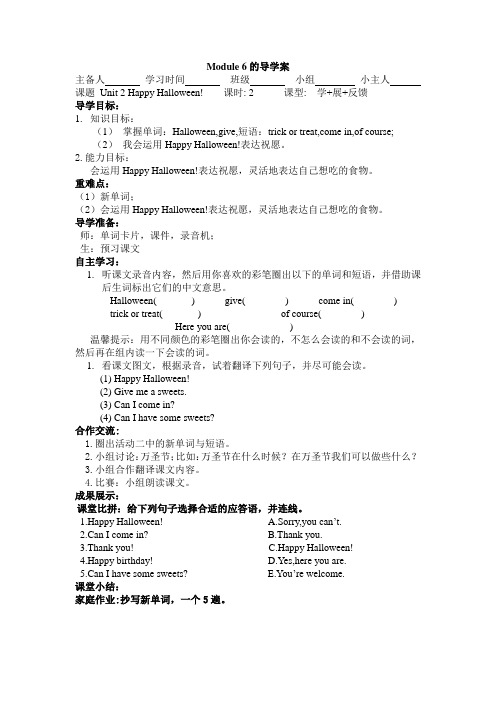
Module 6的导学案主备人学习时间班级小组小主人课题Unit 2 Happy Halloween! 课时: 2 课型: 学+展+反馈导学目标:1.知识目标:(1)掌握单词:Halloween,give,短语:trick or treat,come in,of course;(2)我会运用Happy Halloween!表达祝愿。
2.能力目标:会运用Happy Halloween!表达祝愿,灵活地表达自己想吃的食物。
重难点:(1)新单词;(2)会运用Happy Halloween!表达祝愿,灵活地表达自己想吃的食物。
导学准备:师:单词卡片,课件,录音机;生:预习课文自主学习:1.听课文录音内容,然后用你喜欢的彩笔圈出以下的单词和短语,并借助课后生词标出它们的中文意思。
Halloween( ) give( ) come in( )trick or treat( ) of course( )Here you are( )温馨提示:用不同颜色的彩笔圈出你会读的,不怎么会读的和不会读的词,然后再在组内读一下会读的词。
1.看课文图文,根据录音,试着翻译下列句子,并尽可能会读。
(1) Happy Halloween!(2) Give me a sweets.(3) Can I come in?(4) Can I have some sweets?合作交流:1.圈出活动二中的新单词与短语。
2.小组讨论:万圣节;比如:万圣节在什么时候?在万圣节我们可以做些什么?3.小组合作翻译课文内容。
4.比赛:小组朗读课文。
成果展示:课堂比拼:给下列句子选择合适的应答语,并连线。
1.Happy Halloween! A.Sorry,you can’t.2.Can I come in? B.Thank you.3.Thank you! C.Happy Halloween!4.Happy birthday! D.Yes,here you are.5.Can I have some sweets? E.You’re welcome.课堂小结:家庭作业:抄写新单词,一个5遍。
四年级上册英语(外研版)第一模块导学案
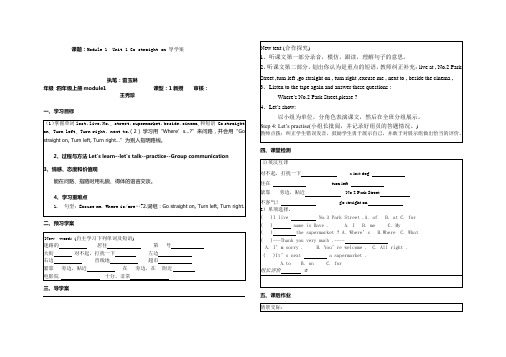
课题:Module 1 Unit 1 Go straight on 导学案年级:四年级上册module1 执笔:雷玉琳王秀珍课型:1新授审核:一、学习目标(1)掌握单词lost,live,No., street,supermarket,beside,cinema,和短语 Go straight on, Turn left, Turn right,next to.( 2 ) 学习用“Where’s…?”来问路,并会用“Go straight on, Turn left, Turn right…”为别人指明路线。
2、过程与方法Let`s learn--let`s talk--practice--Group communication3、情感、态度和价值观能在问路、指路时用礼貌、得体的语言交谈。
4、学习重难点1. 句型:Excuse me. Where is/are…?2.词组:Go straight on, Turn left, Turn right.二、预习学案.New words .(自主学习下列单词及短语)迷路的居住第......号大街对不起,打扰一下左边右边直线地超市紧靠......旁边,贴近在......旁边,在.....附近电影院十分,非常三、导学案New text (合作探究)1、听课文第一部分录音,模仿,跟读,理解句子的意思。
2、听课文第二部分,划出你认为是重点的短语,教师纠正补充:live at , No.2 Park Street ,turn left ,go straight on , turn right ,excuse me , next to , beside the cinema ,3、Listen to the tape again and answer these questions :Where’s No.2 Park Street,please ?4、Let’s show:以小组为单位,分角色表演课文,然后在全班分组展示。
英语四年级上册导学案-阅读(话题:人物)-外研版(三起)
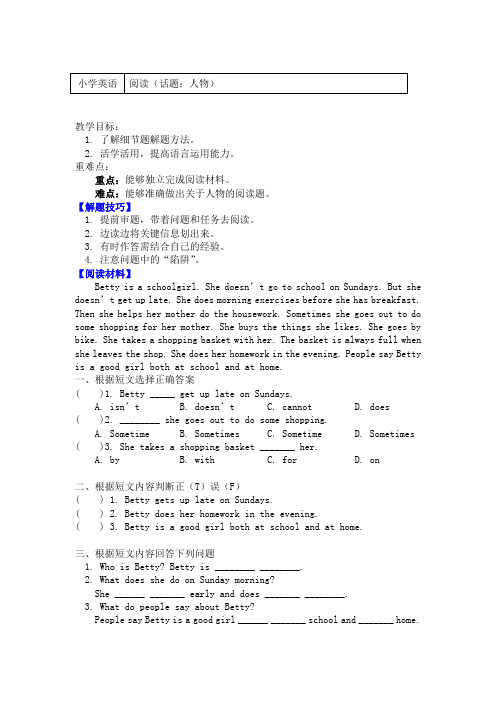
教学目标:1. 了解细节题解题方法。
2. 活学活用,提高语言运用能力。
重难点:重点:能够独立完成阅读材料。
难点:能够准确做出关于人物的阅读题。
【解题技巧】1. 提前审题,带着问题和任务去阅读。
2. 边读边将关键信息划出来。
3. 有时作答需结合自己的经验。
4. 注意问题中的“陷阱”。
【阅读材料】Betty is a schoolgirl. She doesn’t go to school on Sundays. But she doesn’t get up late. She does morning exercises before she has breakfast. Then she helps her mother do the housework. Sometimes she goes out to do some shopping for her mother. She buys the things she likes. She goes by bike. She takes a shopping basket with her. The basket is always full when she leaves the shop. She does her homework in the evening. People say Betty is a good girl both at school and at home.一、根据短文选择正确答案( )1. Betty _____ get up late on Sundays.A. isn’tB. doesn’tC. cannotD. does( )2. ________ she goes out to do some shopping.A. SometimeB. SometimesC. SometimeD. Sometimes ( )3. She takes a shopping basket _______ her.A. byB. withC. forD. on二、根据短文内容判断正(T)误(F)( ) 1. Betty gets up late on Sundays.( ) 2. Betty does her homework in the evening.( ) 3. Betty is a good girl both at school and at home.三、根据短文内容回答下列问题1. Who is Betty? Betty is ________ ________.2. What does she do on Sunday morning?She ______ _______ early and does _______ ________.3. What do people say about Betty?People say Betty is a good girl ______ _______ school and _______ home.一、1. B But she doesn’t get up late.2. B Sometimes she goes out to do some shopping for her mother.3. B She takes a shopping basket with her.二、1. F 原文:But she doesn’t get up late.2. T 原文:Betty does her homework in the evening.3. T 原文:People say Betty is a good girl both at school and at home.三、1. a schoolgirl2. gets up, morning exercise3. both at, at 原文:People say Betty is a good girl both at schooland at home.【试试看】My English TeacherMy English teacher is Paul Rodgers. He is tall, good looking and quite friendly. I think he is about thirty-five years old. He lives in an oldhouse in the middle of the city with his wife and three children. He’s got three sons. Two of them go to school, but the third son is only ababy and stays at home with Paul’s wife, Sue. The students in my classlike Paul because he is funny and his lessons are always interesting. Heis telling us about life in England right now so he shows us videos andphotos of English buildings and famous places. I am not very good at English but I really like it and I like my teacher, Paul.一、根据短文内容判断判断正(T)误(F)( ) 1. Mr. Rodgers is very friendly to his students.( ) 2. I don’t like my English teacher.( ) 3. His sons aren’t all students.二、根据短文内容选择正确答案( ) 1. My English teacher is _______.A. youngB. oldC. over fortyD. older than his wife( ) 2. There are _____ people in my English teacher’s family.A. threeB. fourC. fiveD. six( ) 3. My English teacher is telling us about life in ______ right now.A. UKB. AmericaC. ChinaD. Japan一、1. T 原文:He is tall, good looking and quite friendly.2. F 原文:I am not very good at English but I really like it and I like my teacher, Paul.3. T 原文:He’s got three sons. Two of them go to school, but the third son is only a baby and stays at home with Paul’s wife, Sue.二、1. A I think he is about thirty-five years old.2. C teacher, his wife and three sons3. A He is telling us about life in England right now同步练习:(答题时间:10分钟)An Old ManIt is a beautiful spring morning. The sun is warm but not too hot. Johnson is surprised when he finds an old man at the bus stop with a big, strong umbrella in his hands. Johnson says to him, “Are we going to have rain?”“No,” says the old man. “I don’t think so. I am an old man, so I really need a walking-stick. When I carry a walking-stick, people will say, ‘Look at that poor old man’, and I don’t like that. When I carry an umbrella in fine weather, people only say, ‘Look at that foolish man’.”一、根据短文内容判断正(T)误(F)( ) 1. It is a fine day.( ) 2. An old man with a big, strong umbrella is on the bus.( ) 3. The old man wants to use the umbrella to keep off the rain. ( ) 4. The old man doesn’t like other people to think of him as an old poor man.二、根据短文内容找出含有下列意思的词1. A place where people get on and off the bus: ________________________________2. Something people use in the rain: _____________________________3. Something people use to help walking: _____________________________________4. The opposite(相反的) to clever: _____________________________________5. The opposite to cold: __________________________________________答案:一、1. T 解析:It is a beautiful spring morning.2. F 解析:Johnson is surprised when he finds an old man at the bus stop with a big, strong umbrella in his hands.3. F 解析:I really need a walking-stick.4. T 解析:When I carry a walking-stick, people will say,‘Look at that poor old man’, and I don’t like that. When I carry an umbrella in fine weather, people only say,‘Look at that foolish man’.”二、1. bus stop 公交车站2. umbrella 雨伞3. stick 拐杖4. foolish 傻的5. hot 热的。
英语四年级上册 写一写(Module 1)-导学案-外研版(三起)

学习目标:1. 通过范文赏析,能够读懂文章中的内容。
2. 能够掌握问路的语句并进行类似对话。
重点:熟练运用方位介词。
难点:特殊疑问词的使用。
知识梳理:【范文欣赏】Lily: Excuse me, Sam. What are you doing?Sam: Hi, Lily. I’m playing with my model plane.Lily: Oh, it’s excellent. Where did you buy it?Sam: In a big supermarket.Lily: I want a same one. Where is the supermarket?Sam: Look, It’s at No.3 Blue Street, beside the library.Lily: Sounds great. Can you tell me the way to the supermarket? I’ve got the map.Sam: Ok. You can go straight, and turn left on the second crossing. You can see the big supermarket.Lily: It’s not far away. Let’s go together.Sam: Ok.Lily: Thank you.Sam: You’re welcome. Let’s go!【高频词句】词汇:excuse me; where is ….?; go straight; turn right; thank you; you’re welcome.句型:Where is the …?; It’s at No. ...street.【写写看】根据上面的范文欣赏,将下面的对话补充完整,然后分角色朗读一下吧,快来试试看!词汇:excuse me; where is ….?; go straight; turn right; thank you; you’re welcome.句型:Where is the …?; It’s at No. ...street.Lily: ____1____, Sam. What are you doing?Sam: Hi, Lily. I’m playing with my model plane.Lily: Oh, it’s excellent. ____2____ did you buy it?Sam: In a big supermarket.Lily: I want a same one. Where is the supermarket?Sam: Look, It’s at No.3 Blue Street, beside the library.Lily: Sounds great. Can you tell me the way to the supermarket? I’ve got the map.Sam: Ok. You can go ____3____, and ____4____ left on the second crossing. You can see the big supermarket.Lily: It’s not far away. Let’s go together.Sam: Ok.Lily: Thank you.Sam: You’re ____5____. Let’s go!答案:1. Excuse me2. Where3. straight4. turn5. welcome同步练习:(答题时间:20分钟)一、英汉互译。
四年级英语上导学案-Module 9 Happy Birthday _外研版

外研社(三起)四年级英语上册Module 9 Happy BirthdayUnit 1 Can I have some sweets?第一课时教学目标:情感目标:培养学生学习英语的兴趣。
知识目标:学习句型Can I have some…? Yes, you can. / Sorry, you can’t.能力目标:培养学生运用英语请求获得允许和谈论实物的能力。
教学重点:1 学习运用Can I have some…? 句型。
2 掌握单词及词组:sweet\biscuits\soup\bread教学难点:能够正确理解运用Can I have some…? 句型及做出正确的回答。
辅助资源:挂图、录音机、磁带、图片、VCD、一些食物、自制拼图教学过程:I. Warming up唱歌曲Happy Birthday.II. Revision:1.Do duty report“What day is today? What is the date today? What’s the weather like today?”2.让学生来猜一猜今天是谁的生日。
III. Presentation:1.请学生看课文VCD,得出答案:“今天是Amy的生日。
”(VCD精彩的画面可以吸引学生的注意力,还可以有效的帮助学生理解课文)2.出示问题:“What does Amy want?”请学生再次听课文录音。
3.教师出示一些食品的图片,要求学生从中选择出Amy 想要的东西。
”soup/ sweets/ bread/ biscuits.”4.看图片学说单词sweet/sweets/soup/biscuits/bread教说biscuits时,教师取出一些饼干,告诉学生,如果他们想要吃饼干的话,可以对老师说Can I have some biscuits? 学说新句型Can I have some…?( 小小的饼干可以为学生创设真实运用新句型Can I have some biscuits?的情境,学生想吃饼干必然就要学会说这个句子,学生学习英语的热情会极大的得到提高。
外研社(三起点)四年级英语上册第二模块导学案

Module 2第一课时Unit 1 She’s reading a book.教学目标1. 全体学生能理解词汇:read, running, these, picture, take, take pictures2. 全体学生能初步运用词汇:reading, running, taking3. 感知现在分词的读音。
4. 全体学生能初步运用She’s reading a book. He’s taking pictures. 来谈论图片上正在发生的事情。
学习策略通过归纳现在分词的构成,尝试通过观察对所学内容进行必要的归纳。
文化意识通过学习现在进行时,了解英国普通家庭的日常生活。
教学重点运用He/She+is+doing讲述图片上正在发生的事情。
教学难点现在分词的构成形式及读音。
教学准备PPT,互动教学系统,点读笔教学过程一、热身导入1. Greetings.The teacher says hello to all the students.2. Do and say.Teacher does some actions, and the students say the phrases. Eg: playing football, playing basketball, swimming, running.3. Lead-in(1) Show the students Lingling’s pictures, and describe them. (强调like doing结构)今天,Lingling给我们带来了一些照片,一起去看看他们都在做什么吧!(2) Teach the word “running”.(3) Listen and read. 注意模仿录音中的语音语调。
教师对学生的读音进行指正。
(4) Read together.二、任务呈现展示假期生活的图片,描述图片中正在发生的事情以及自己的活动。
外研版(三起点)四年级上册Module9 Unit 1
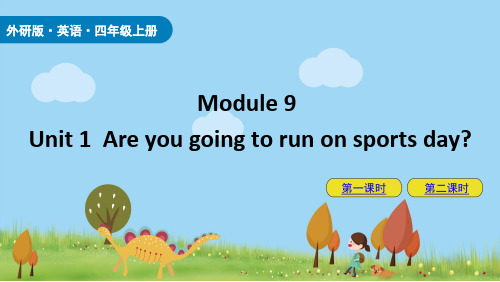
Do you want to be the
winner?
winner 冠军
You should run every day.
每个,每一 一天,一日
Watch the.
( A ) 1. 大明要去参加比赛,早上出门,他妈妈对他说:
A. Good luck.
_A_r_e__y_ou__g_o_in_g_t_o__ru_n__t_om__o_rr_o_w_?_____ 2. going, to, I’m, 100, run, the, metres (.)
_I_’m__g_o_in_g__t_o_r_u_n_t_h_e__10_0__m_e_t_r_e_s.____
1. Is Daming going to run on sports day?
Yes, he is going to run on sports day.
2. Is Daming going to school now?
No, he is going to run in the park.
3. Who is the winner?
Are you going to run on sports day? Which one? I’m going to run the 100/200/400 metres.
1米=one metre 100米=one hundred metres
200米=two hundred metres
300米=? 400米=?
- Yes, I’m going to swim.
A. swim
B. swimming
二、找出下面单词的汉语意思。
1. Come on!
√
加油!
(三起点)外研版四年级英语上册《Module3_Unit1_景德镇优课教学设计》
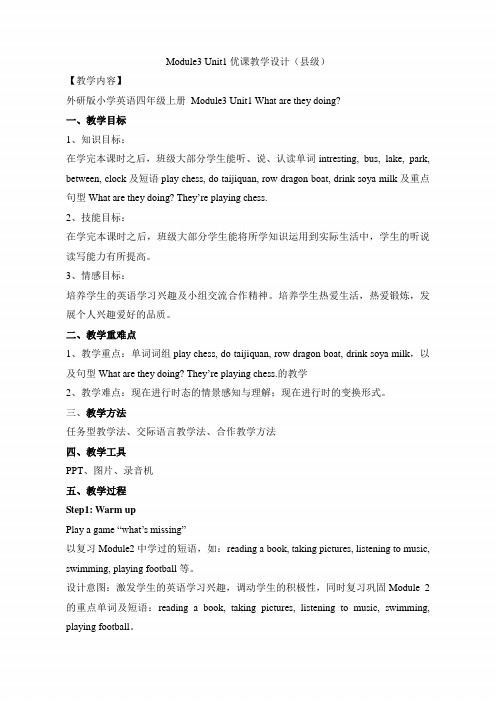
Module3 Unit1优课教学设计(县级)【教学内容】外研版小学英语四年级上册Module3 Unit1 What are they doing?一、教学目标1、知识目标:在学完本课时之后,班级大部分学生能听、说、认读单词intresting, bus, lake, park, between, clock及短语play chess, do taijiquan, row dragon boat, drink soya milk及重点句型What are they doing? They’re playing chess.2、技能目标:在学完本课时之后,班级大部分学生能将所学知识运用到实际生活中,学生的听说读写能力有所提高。
3、情感目标:培养学生的英语学习兴趣及小组交流合作精神。
培养学生热爱生活,热爱锻炼,发展个人兴趣爱好的品质。
二、教学重难点1、教学重点:单词词组play chess, do taijiquan, row dragon boat, drink soya milk,以及句型What are they doing? They’re playing chess.的教学2、教学难点:现在进行时态的情景感知与理解;现在进行时的变换形式。
三、教学方法任务型教学法、交际语言教学法、合作教学方法四、教学工具PPT、图片、录音机五、教学过程Step1: Warm upPlay a game “what’s missing”以复习Module2中学过的短语,如:reading a book, taking pictures, listening to music, swimming, playing football等。
设计意图:激发学生的英语学习兴趣,调动学生的积极性,同时复习巩固Module 2的重点单词及短语:reading a book, taking pictures, listening to music, swimming, playing football。
英语四年级上册 写作(话题:颜色)-导学案-外研版(三起)
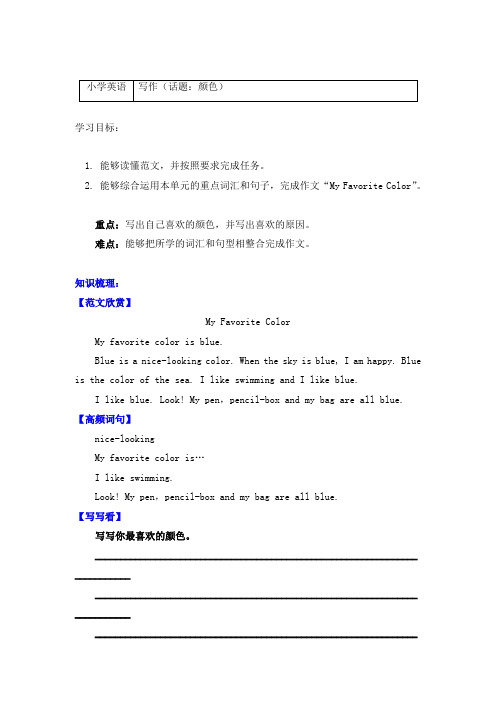
学习目标:1. 能够读懂范文,并按照要求完成任务。
2. 能够综合运用本单元的重点词汇和句子,完成作文“My Favorite Color”。
重点:写出自己喜欢的颜色,并写出喜欢的原因。
难点:能够把所学的词汇和句型相整合完成作文。
知识梳理:【范文欣赏】My Favorite ColorMy favorite color is blue.Blue is a nice-looking color. When the sky is blue, I am happy. Blue is the color of the sea. I like swimming and I like blue.I like blue. Look! My pen,pencil-box and my bag are all blue. 【高频词句】nice-lookingMy favorite color is…I like swimming.Look! My pen,pencil-box and my bag are all blue.【写写看】写写你最喜欢的颜色。
________________________________________________________________ ___________________________________________________________________________ _________________________________________________________________________________________________________________________________________________________________参考范文:My favorite color is red. I like red because it is the color of the sun. I like sunny days, so I like red.I like red. Look! My pencil box, my book and my bag are all red.同步练习:(答题时间:15分钟)在空格处填写适当的单词,完成作文。
[新版]外研版(三起点)四年级英语上册Module10模块整体教案[精品
![[新版]外研版(三起点)四年级英语上册Module10模块整体教案[精品](https://img.taocdn.com/s3/m/31ad415fc1c708a1294a4456.png)
[新版]外研版(三起点)四年级英语上册Module10模块整体教案[精品(本文档为word格式。
下载后可以修改,直接打印!)模块10模块总体教学计划1,模块教材分析本模块为外国研究所小学英语教材四年级(高年级)第十模块。
本单元以“节日”为主题,旨在学习新年的活动和问候,了解西方的圣诞节,比较中西文化。
教科书创造了“我们有一顿丰盛的家庭晚餐”和“圣诞快乐”真实情况导致两组关于春节和圣诞节的情景对话,一首圣歌,一首英文歌和多个任务项目。
春节和圣诞节是中国和西方最大的节日。
它们也是学生非常感兴趣的话题。
四年级的学生已经掌握了节日的问候。
通过本模块,学生可以听、说、读、写与春节和圣诞节相关的词汇。
他们可以学习介绍春节和圣诞节的主要活动,例如“在春节/圣诞节,我们有……”了解中西方的风俗和文化差异,积极了解中外节日,从而拓展视野,提高跨文化交际能力。
二、模块教学目标(1)知识目标(1)能听、说、读、写四个字家庭、年份、汉语;;能听、说、读晚餐、节日、新年和其他单词和短语(2)将被使用:在春节,我们有一个大的家庭晚餐。
我们...这是你的礼物。
merryChristmas和其他句型用节日问候互相问候,可以介绍春节/圣诞节的主要活动,可以在实际情况中巧妙运用。
(3)能说唱一点圣歌;我会唱一首英文歌“我们祝你圣诞快乐。
”(ii)能力目标(1)理解并使用节日词汇和句型表达节日问候(2)描述春节和圣诞节的习俗,介绍他们的主要活动(3)情感态度目标(1)提高传统节日意识,增强爱国主义和亲情意识(2)能乐于接触外国文化,提高将现实生活与英语学习相结合的能力。
(4)学习策略目标(1)能积极运用所学知识进行表达和交流(2)可以总结和比较所学的内容(5)文化意识目标在学习和日常交际中,了解中西节日的异同,增强学生的跨文化交际意识了解英语国家的重要节日模块教学设想模块课时安排建议:共分4个课时第一课时:模块10单元1我们有一顿丰盛的家宴。
英语四年级上册 写一写(Module 4)-导学案-外研版(三起)

学习目标:运用现在进行时和“Do you want some…?”组对话,造句子。
重点:学会使用词汇:noodles, dumplings, eggs, cake, rice…难点:学会使用句型:be doing;Do you want some…知识梳理:【范文欣赏】Hi, I am Dick. I am doing my homework in my bedroom. My mom is cooking in the kitchen. She is making a cake. I am hungry. I want some cakes. 【高频词句】词汇:hungry, cook短语:do one’s homework, make a cake句型:be doing; sb. want sth.【写写看】What are you doing, Mum?I’ m making dumplings.Can we help you?Can you go to buy some eggs?Of course.Can I help you?We want some eggs. How much is it?Six yuan for ten.Ten, please.Here you are.Thank you.Bye-bye.根据课文中此对话,设计场景,改编属于自己的对话。
At home:_____________________________________________ _____________________________________________ _____________________________________________ _____________________________________________In the shop:_____________________________________________ _____________________________________________ _____________________________________________ _____________________________________________At home:Zip: What are you doing, dad?Dad: I’m making noodles.Zip: Can I help you?Dad: Can you go to buy some milk?Zip: Of course.In the shop:Woman: Can I help you?Zip: I want some milk. How much is it? Woman: Five yuan for two. Here you are.Zip: Thank you. Bye-bye.同步练习:(答题时间:15分钟)从下面图片中任选其一,编写对话。
小学四年级英语上册M4-M6复习导学案(外研版)

四年级英语上册M4-M6复习导学案(外研版)四年级英语教案四年级英语上册:M4-M6复习导学案(外研版)M4 ------ M6【学习目标】: 1. 问别人是否需要吃东西。
Do you want some --- ?Yes, please. / No, thank you.2. 问别人要东西吃。
Can I have some --- ?Yes, you can. / Sorry, you can’t.3. 问别人会 --- 吗? Can + 主语 + 动词 + 其它。
【学习重难点】: 能熟练运用上述句型。
【学法指导】对比法自主学习【知识呈现】一. 问别人是否要吃东西。
(10’)1. Do you want some + 事物? 你想要---吗?Yes, please. / No, thank you.2. Can I help you ?练习 1. 翻译花________ 美味的________ 制作_________Some________ also_________ want________2.填空A. --- Do you _____ _____ milk ?--- Yes, ___________.B. --- _____ you _____ some noodles ?--- No, ______ ______ .C. He’s ______ _______. (正在做面条)D. How __________ ?(多少钱)二. 向别人要东西吃(15’)Can I have some + 食物 ?Yes, you can . / Soory, you can’t.练习 1.翻译汤________ 面包________ 糖果_________灯_________ 饼干________ 水果_________2. 填空A. Can I ________ _______(进来) ? Yes, __________.B. 我可以吃些糖吗? Can _____ _____ _____ _____ ?抱歉,不可以。
- 1、下载文档前请自行甄别文档内容的完整性,平台不提供额外的编辑、内容补充、找答案等附加服务。
- 2、"仅部分预览"的文档,不可在线预览部分如存在完整性等问题,可反馈申请退款(可完整预览的文档不适用该条件!)。
- 3、如文档侵犯您的权益,请联系客服反馈,我们会尽快为您处理(人工客服工作时间:9:00-18:30)。
最新外研版小学四年级英语学科导学案
主备教师
授课时间
课 题
Module 1 unit1
Go straight on .课 型新Fra bibliotek课课 时
1
教学目标
知识与技能
能够正确听、说、认读表示方向的词以及短语。如:left. Right,turn right(left). Go straight on 等,掌握问路的基本用语。
9. hse 房屋 10.spermrket 超市
释
难
解
疑
beside the tree 在树后面
on your right 在你的右边
next to a cinema 靠近电影院
拓
展
训
练
翻译句子
1.你在哪里? 我在你的右边。
2.汤姆在哪里? 他在树后面。
作业设计
1、完成课堂检测中的相关习题。
2、结合本课内容创编一个新对话并将其表演出来。
9. next to a cinema 10. beside the cinema
11. Thank you so much !
展
示
反
馈
根据汉语意思将单词补充完整
1、lft 左边;向左 2、rght 右边;向右
3、lve 居住 4、strt 街道
5、trin 火车 6、bsde 在···旁边
7. cinema电影院 8.ne接近,临近
主备教师
授课时间
课 题
Module 1 unit1
Go straight on .
课 型
新授课
课 时
2
教学目标
知识与技能
复习巩固单词,能够运用turn left , go straight on . 等短语进行指路。
过程与方法
掌握问路的句型,进行简单的交际对话。并在真实场景中运用所学语言进行真实交流和运用。
A: Thank you . Goodbye .
B: Bye-bye .
作业设计
1、完成课堂检测中的相关习题。
2、背写活动4。
板书设计
Unit 1 Go straight on
Turn right turn left go straight on
最新外研版中小学四年级英语学科教案
主备教师
授课时间
课 题
过程与方法
能听懂、会表演文中对话内容,并在真实场景中运用所学语言进行真实交流和运用。
情感态度价值观
在对话交流中养成用英语交流的习惯,培养良好的语音、语调和语感。
教材分析
教学重点
能够表演对话内容,能够根据实际情况用英语问路和指路。
教学难点
熟练运用问路的基本句型。
学 具
录音机、磁带、单词卡片
教 学 过 程
B:straight on . Turn right .
A: Thank you so.
B:You’re.
释
难
解
疑
straight on 直着走
Turn right 向右转
Turn left 向左转
拓
展
训
练
A: Excuse.is the zoo ,please ?
B:left . Go straight. It’s nexta cinema .
Module2 Unit 2 It’s at the station
课 型
新授课
课 时
1
教学目标
知识与技能
能够正确听、说、朗读句型:The train is going up/down/past the hill.
能够正确听、说、认读单词: hill, house ,station, train, up, down.
4. 组内分角色表演活动2
小
组
合
作
翻译短语或句子。
1. beside the tree 2. on your left
3. on your right 4. at No. 2 Park Street
5. Excuse me . 6. Go straight on .
7. Turn left . 8. Turn right .
2.检测
听写单词,
1.读本课单词
2.挑写单词
3.组内检查纠错评比
自
主
学
习
根据图片指示说出行走路线。
1.自读活动3、4并翻译
2.同桌互读
3.组内纠错
小
组
合
作
1.组内检查交流。
2.小组表演所造对话。
3.优秀小组展示对话。
展
示
反
馈
填入适当的词完成对话。
A:me . Wherethe supermarket ?
过程与方法
能够听懂、会说、会表演对话的内容,并在真实场景中运用所学语言进行真实交流。
情感态度价值观
在交流对话中养成运用英语交流的习惯,培养学生乐于助人的品质
教材分析
教学重点
学习句型The train is going up/down/past the hill.
教学难点
掌握表示地点和方位的词
学 具
录音机、磁带.
环节
教 师 活 动
学 生 活 动
效果反思
导
入
新
课
听音乐导入
1.听录音,模仿单词发音。
2.组内同读
3、识记单词。
4、组内提问,共同提高,做好展示竞争准备
5. 组内朗读活动1。
6. 组内分角色表演活动2.
自
主
学
习
1.教师领读单词。学生跟读。
2.教师领读句子,学生跟读。
1.识记单词
2.组内同读
3.组内朗读活动1。
1 出示火车图片并说:There’s a train from Beijing to our city.Where is the train going? 将火车贴在山上的位置,引导学生说出:“The train is going up the hill.板书该句子。
情感态度价值观
在对话交流中养成用英语交流的习惯,培养良好的语音、语调和语感。
教材分析
教学重点
掌握问路的句型,能够根据实际情况用英语问路和指路。
教学难点
进行交际对话,熟练运用问路的基本句型。
学 具
录音机、磁带、单词卡片
教 学 过 程
环节
教 师 活 动
学 生 活 动
效果反思
导
入
新
课
1.复习检测
识记复习本课单词
板书设计
Unit 1 Go straight on
Where are you ? I’m…
Where is…? It’s...
Behind on … left on …right
Turn right turn left next to
Beside go straight on
最新外研版小学四年级英语学科导学案
教 学 过 程
环节
教 师 活 动
学 生 活 动
效果反思
导
入
新
课
I. Warming up
TPR活动:教师或一名同学下口令turn left/stand up/sit down等,全班学生做动作。
II. Revision:
请几名学生展示自己上节课画的路线图并向大家介绍从自己家到学校的路线,教师可把学生的路线图用投影放出来。
